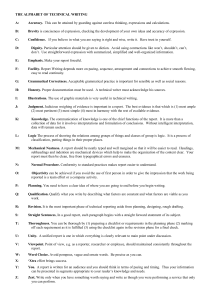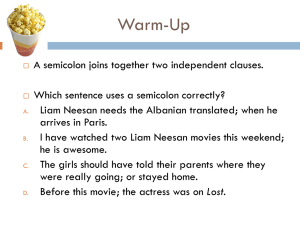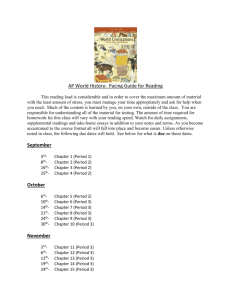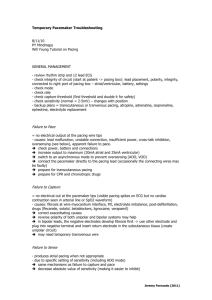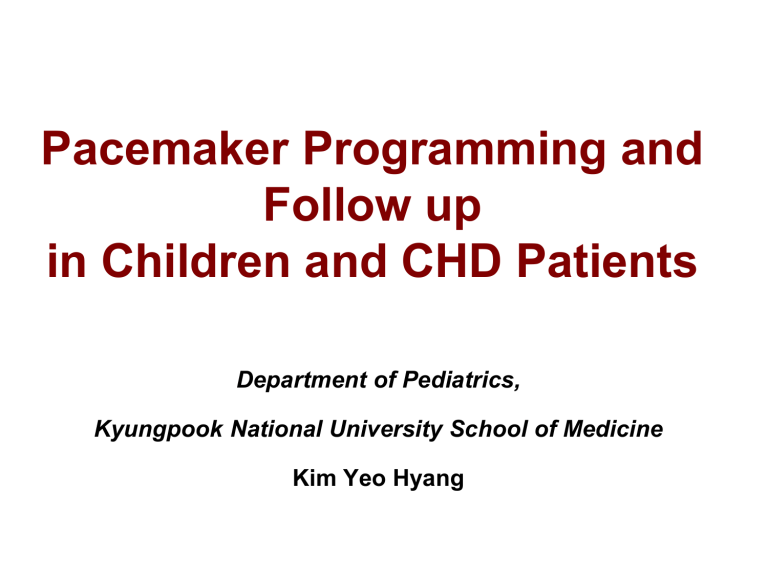
Pacemaker Programming and Follow up in Children and CHD Patients Department of Pediatrics, Kyungpook National University School of Medicine Kim Yeo Hyang Introduction • Major differences in the etiology of AV block in children and adults • Same pacing systems and leads in both age groups • Patient size, body growth, coexistence of CHD, presence of residual intracardiac shunts and life style • Understanding of modern pacing system Contents • Selecting a Pacing System • Programming of the Device • Pacemaker Follow Up Procedure • Echocardiographic follow-up Selecting a Pacing System • Transvenous (endocardial) or surgical (epicardial) route • The choice of route is dependent upon size of the patient, anatomy, surgical procedures performed Epicardial Lead Implantation • < 15 kg • patients with intracardiac shunt lesions • patients with limited access to the atrium or the ventricle (single ventricular physiology, post Fontan palliation) • patients with prosthetic tricuspid valves • Dual chamber epicardial pacemakers : over 3 kg Advantages • Preservation of the venous access for future use Disadvantages • sternotomy or thoracotomy or subxiphoid approach • higher chronic stimulation threshold • higher lead failures and fractures • early depletion of battery life Endocardial Lead Implantation Advantages • avoidance of thoracotomy • lower pacing thresholds • lower incidence of lead fractures Disadvantages • greater risk of lead dislodgment • venous occlusion • embolic vascular events, endocarditis Single vs Dual Chamber Device • AV synchronous pacing • Pacemaker syndrome Unipolar and Bipolar Leads • recent advances in lead design • the marginal differences between unipolar and bipolar leads Specific Considerations • Dual chamber system in patients with ventricular dysfunction with or without CHD • Epicardial pacing system to the heart after the Fontan procedure + AV synchrony • Epicardial pacing system to the heart with intracardiac right-to-left shunting • Patient size and somatic growth Programming of the Device Choice of Stimulation Mode • AV node conduction • dual chamber pacemaker • constant AV synchrony and sinus-based chronotropy NBG Code I II III IV V Chamber(s) Paced Chamber(s) Sensed Response to Sensing Rate Modulation Multisite Pacing O = None O = None O = None O = None O = None A = Atrium A = Atrium T = Triggered R = Rate A = Atrium V = Ventricle V = Ventricle I = Inhibited D = Dual (A + V) D = Dual (A + V) D = Dual (T + I) S = Single (A or V) S = Single (A or V) modulation V = Ventricle D = Dual (A + V) Pacemaker Patient Follow-up Follow up Interval • prior to discharge • in 1–2 weeks for incision check • 2–3 months to assess chronic pacing thresholds and cardiac function (because of the risk of pacing-induced cardiac dysfunction) • every 6 months • any change in clinical status occurs Pacemaker Follow-up Steps • Evaluating the device – Determine the battery voltage – Check the lead impedance – Test capture thresholds – Test sensing thresholds – Perform a magnet/non-magnet test • Underlying rhythm Optimizing Pacemakers for Patients • Always evaluate the rate histograms • Always evaluate for the presence of arrhythmia • Always evaluate the percent pacing Complications Lead Complication • lead fracture • dislodgement • high thresholds • insulation break • epicardial vs endocardial leads Risk Factors for Lead Failures • younger age at implant • presence of congenital heart disease • epicardial pacing leads Prevention of Lead Complication • routine and regular pacemaker interrogation • routine chest radiography 7세 24kg 125cm 12세 45kg 154cm Pacemaker Related Infections • Before hospital discharge • During early follow-up • Down syndrome • Revision of a pulse generator with or without pacemaker lead exchange • pacemaker-related infection 7.8% • superficial cellulitis 4.9% • deep pocket infection 2.3% • pacing lead infection 0.5% Postpericardiotomy Syndrome • 2 – 6% of children following initial pacemaker implantation of both epicardial and transvenous lead systems • Within 14 days after pacemaker placement : most • Late onset : some Pacing induced Ventricular Remodelling and Dysfunction • Pacing from the RV apex - LV dyssynchrony - ventricular remodelling and dysfunction • Children with life-long pacing Pacing Induced Ventricular Dyssynchrony • disturbs myocardial regional workload and wall stress • wall motion abnormalities • myocardial perfusion defects • changes in coronary blood flow • increased left ventricular cavity volume • asymmetrical changes in left ventricular wall thickness • interstitial and cellular histopathological alterations 26 To Minimize Ventricular Pacing • Identification of risk factors for pacing-induced cardiomyopathy • Unravelling its pathogenesis • Pacing strategies to avoid the adverse effects of right ventricular apical and lateral wall pacing • Pacing strategies that reduce unnecessary ventricular pacing the cumulative percentage of ventricular pacing 27 Serial Echocardiographic Investigations • Measuring LV dyssynchrony, regional and global ventricular function • Conventional echocardiographic parameters are not sensitive • Tissue Doppler echocardiography and Speckle tracking imaging Conclusion • Pacing in children : a safe and feasible therapy • Selecting an appropriate pacemaker system : several patient-related and pacemaker-related issues • Early establishment of AV synchrony • Pacemaker-induced ventricular dysfunction and adverse remodelling 29 Thank you !!! 30
